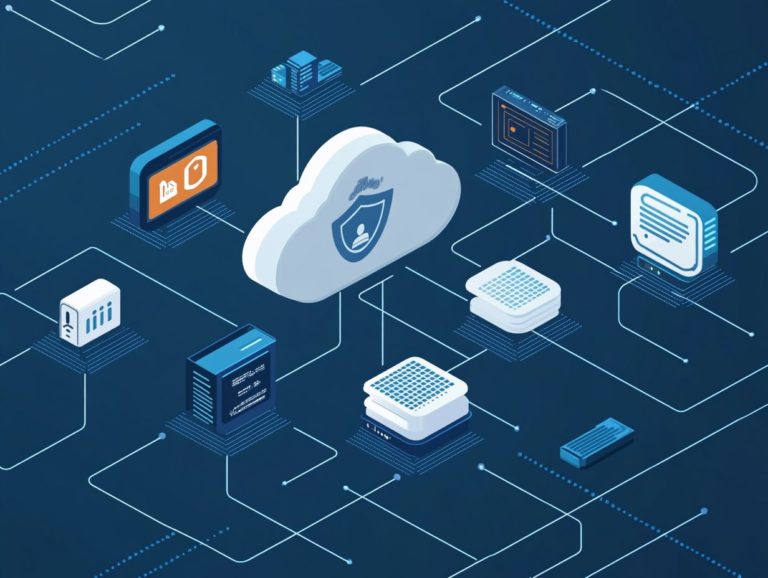Top 10 Cloud Security Threats to Watch Out For
In today’s digital landscape, the cloud has emerged as a fundamental pillar of business operations. However, it also introduces a myriad of security challenges.
From data breaches to insider threats, cloud security is laden with risks that could jeopardize your organization s sensitive information.
This article will illuminate the top 10 cloud security threats you need to know about, providing valuable insights into their causes, consequences, and effective strategies to safeguard your business.
By staying informed and proactive, you can fortify your cloud environment against these potential threats.
Contents
- Key Takeaways:
- 1. Data Breaches
- 2. Insider Threats
- 3. Insecure APIs
- 4. DDoS Attacks
- 5. Malware Infections
- 6. Beware: Misconfigurations Can Cost You!
- 7. Insufficient Identity and Access Management
- 8. Lack of Encryption
- 9. Shared Technology Vulnerabilities
- 10. Compliance and Legal Issues
- What Are the Common Causes of Cloud Security Threats?
- Frequently Asked Questions
- What are the top 10 cloud security threats to watch out for?
- What is a data breach and how does it pose a threat to cloud security?
- How do insecure APIs put cloud security at risk?
- What are shared technology vulnerabilities and how can they affect cloud security?
- What is inadequate due diligence and why is it a concern for cloud security?
- How can organizations protect against the top 10 cloud security threats?
Key Takeaways:
Here are the crucial points you can’t afford to overlook!

- Implement strong security measures to prevent data breaches caused by weak security protocols and unauthorized access.
- Establish proper identity and access management to mitigate insider threats from employees or contractors with malicious intent.
- Thoroughly assess and secure Application Programming Interfaces (APIs) to protect your cloud infrastructure from vulnerabilities.
1. Data Breaches
Data breaches stand as one of the most formidable threats to cloud security today. They often lead to unauthorized access and theft of sensitive personally identifiable information, wreaking havoc for individuals and organizations alike.
As cybercrime is changing, it’s essential to grasp the intricacies behind data breaches, such as the impact of misconfigured cloud storage and inadequate risk assessments. Leading companies like NetApp and CrowdStrike are pioneering advanced strategies, emphasizing encryption protocols and rigorous security controls to mitigate these pervasive risks.
Human error significantly contributes to many breaches, whether it s clicking on phishing links or mishandling sensitive information. Misconfigured cloud services can leave your organization exposed, putting your data at considerable risk from cyber threats.
When breaches happen, the financial fallout can be staggering. Costs for remediation, legal fees, and potential fines under regulations like PCI DSS and HIPAA can escalate quickly. The reputational damage can erode customer trust and diminish market share, underscoring the importance of implementing robust security measures to safeguard your data and your business s integrity.
2. Insider Threats
Insider threats present a distinct and often underestimated risk to cloud security. Individuals within an organization may exploit their privileged access to sensitive data, leading to grave consequences like cyber attacks and data theft.
These threats can take different forms. They may arise from inadvertent actions, such as unintentional data sharing or mishandling access credentials due to negligence. Other times, they stem from malicious intent, where employees consciously seek to harm the organization for personal gain.
Recent economic downturns have intensified these risks. Financial pressures can drive individuals to engage in unethical behavior, fueled by desperation or greed. Consider the case of a financial services firm that fell victim to an insider stealing client data. This incident illustrates that such threats are not solely driven by personal motives but are also influenced by external economic factors.
Grasping these dynamics is vital for your organization’s security.
3. Insecure APIs
Insecure APIs present significant vulnerabilities within cloud environments, broadening the attack surface for potential data breaches. Robust API security is essential to safeguard against advanced persistent threats and unauthorized access.
The consequences of misconfigured APIs can be severe, leading to unauthorized data exposure, injection attacks, or even service disruptions. These vulnerabilities often stem from inadequate authentication, insufficient logging, or excessively permissive permissions.
To counteract these risks effectively, you should adopt a series of best practices, such as:
- Utilizing secure coding techniques
- Enforcing strict access controls
- Regularly auditing API endpoints
By integrating threat hunting into your security strategy, you can proactively identify and mitigate weaknesses before they can be exploited. This approach enhances your overall situational awareness and response capabilities against evolving threats.
Don’t wait until it’s too late! Start assessing your cloud security today!
4. DDoS Attacks
Distributed Denial of Service (DDoS) attacks are a significant concern in cloud security. They aim to overwhelm and disrupt services, posing serious risks for businesses relying on cloud service providers.
These attacks cleverly exploit the expanded attack surface that cloud architectures present. Public endpoints are much easier to target than those in traditional networks.
As you transition your operations to the cloud, having strong methods for finding threats becomes critical. Recent trends show a rise in DDoS attacks that use multiple methods at once, combining tactics like volumetric floods and application-layer assaults to amplify their impact.
You must act now to protect your services! Implement effective security controls such as traffic filtering and anomaly detection to mitigate risks and ensure service continuity in this complex threat landscape.
Your organization s resilience relies on staying a step ahead of these evolving threats.
5. Malware Infections
Malware infections pose a significant threat to cloud security. They can lead to data loss, system breaches, and extensive cyberattacks that compromise sensitive information stored in cloud environments.
The malware landscape is varied, featuring threats like ransomware that can lock you out of your data and trojans that stealthily infiltrate systems to steal credentials. These malware types disrupt your operations and expose your organization to financial and reputational damage.
You must combat these threats effectively to safeguard your future! Implement robust encryption methods that protect your data both in transit and at rest, making it more difficult for attackers to exploit vulnerabilities.
Proactive threat-hunting techniques are vital for identifying and eliminating risks before they escalate. This ensures a more resilient cloud environment for you.
6. Beware: Misconfigurations Can Cost You!

Misconfiguration of cloud services is a leading cause of security vulnerabilities. Often stemming from human error, these misconfigurations can lead to data breaches that expose sensitive information to unauthorized access.
They can manifest in various ways, from incorrectly set permissions to exposed storage buckets. The complexity of cloud environments complicates matters as you manage multiple services and configurations that may overlap or conflict.
To mitigate these risks, adopt best practices for configuration management. Regular audits and automated monitoring tools can significantly reduce your vulnerabilities.
Cloud service providers offer built-in security features and best practice guidelines to help you maintain a secure posture. This is essential for safeguarding your data.
7. Insufficient Identity and Access Management
Insufficient identity and access management in cloud environments exposes you to significant security risks. Insider threats and unauthorized privileged access can jeopardize your sensitive data.
Effective identity and access management (IAM) means managing user identities, roles, and permissions with precision. Establish clear access policies and consider tools that facilitate these controls seamlessly.
A well-implemented IAM system incorporates multi-factor authentication, adding extra security by requiring more than one form of verification. Regularly auditing access logs helps you spot and address any anomalies before they turn into serious breaches.
By adopting these strategies, you can enhance cloud security and foster a culture of vigilance against potential threats.
8. Lack of Encryption
A lack of proper encryption protocols in your cloud storage can expose your organization to serious security risks. These risks include data breaches and insider threats, making encryption essential for your cloud security strategies.
Without robust encryption, sensitive information such as personal data, financial records, and intellectual property remains vulnerable to unauthorized access. In today s fast-paced digital world, protecting your sensitive data has never been more critical! It s imperative that you prioritize encryption to safeguard your assets and maintain the trust of your clients.
You ll find various encryption standards, like AES (Advanced Encryption Standard) and RSA (Rivest-Shamir-Adleman), each offering different levels of security and usability. It’s crucial to evaluate which one aligns best with your operational needs.
Failing to comply with industry regulations on data protection can lead to significant legal consequences and financial penalties. Ignoring these regulations can result in severe financial penalties and even legal action against your organization. Just look at the case studies of companies that faced extensive reputational damage and losses due to inadequate encryption measures; they serve as cautionary tales for anyone neglecting this vital aspect of security.
Shared technology vulnerabilities pose a significant challenge in cloud security, exposing you and other tenants within a cloud environment to potential cyber attacks. This not only increases the attack surface but also opens the door for malicious actors to exploit weaknesses.
These vulnerabilities often stem from the interconnected nature of resources and services provided by cloud platforms. This complicates the isolation necessary for security and heightens the risk of cross-tenant exploitation. Recent high-profile breaches, particularly those involving inadequate segregation in public cloud services, serve as stark reminders of how shared resources can act as gateways for attackers.
The repercussions of such breaches impact not only the organizations directly involved but also erode customer trust across the industry.
To mitigate these risks, it s essential for you to comply with industry standards and regulations. This compliance establishes a framework for securing shared environments and ensures that security protocols are prioritized to protect your sensitive data effectively.
10. Compliance and Legal Issues
Compliance and legal issues in cloud security are crucial for you, as navigating complex regulations like HIPAA and PCI DSS is essential to prevent data breaches and protect sensitive information from insider threats.
In a landscape where data is proliferating at an alarming rate, the stakes are higher than ever. Noncompliance can result in hefty fines, reputational damage, and a significant loss of customer trust.
You face the challenge of adhering to these legal standards while also implementing robust security measures to safeguard your data. Here are three strategies to help you achieve compliance while maintaining strong security:
- Incorporate automated compliance management tools.
- Conduct regular audits.
- Foster a culture of security awareness among your employees.
By weaving compliance into your overall security strategy, you can effectively mitigate risks and ensure that you meet your legal obligations.
What Are the Common Causes of Cloud Security Threats?
Common causes of cloud security threats involve a range of factors, such as human error, misconfigurations, and the ever-shifting landscape of cyberattacks. Together, these elements create a complex attack surface that you must navigate to protect your data.
These vulnerabilities are often worsened by insufficient training among employees, who may inadvertently expose sensitive information through phishing scams or poor password practices. For instance, recent studies indicate that over 80% of data breaches are attributed to human oversight.
Misconfigured cloud settings can lead to unauthorized access, as illustrated by incidents involving major corporations that left their exposed databases unsecured. To mitigate these risks, organizations like yours are encouraged to conduct regular vulnerability assessments and implement a comprehensive cloud security strategy that includes:
- Employee training.
- Automated configuration checks.
- Continuous monitoring for suspicious activities.
In conclusion, addressing these common challenges in cloud security is vital. By prioritizing encryption, adhering to compliance, and being aware of vulnerabilities, you can protect your organization and build trust with your clients.
How Can Businesses Protect Themselves from Cloud Security Threats?

To safeguard against cloud security threats, implement comprehensive risk assessment strategies. Also, use robust security controls like encryption and effective identity management to protect sensitive information.
Cultivating a culture of security awareness among your employees is essential. Regular training sessions will enable your team to recognize phishing attempts and understand their critical role in upholding security protocols.
Regularly checking your security measures helps your organization identify and address systemic vulnerabilities while evaluating the effectiveness of existing safeguards.
Embracing threat hunting techniques actively looking for potential security risks can significantly bolster your organization s ability to detect and respond to risks before they escalate into critical issues.
What Are the Key Differences Between On-Premise and Cloud Security?
Understanding the key differences between on-premise and cloud security is crucial for your organization. The transition to cloud environments shifts the attack surface and requires unique security controls to effectively mitigate data breaches.
When considering infrastructure management, remember that on-premise solutions give you full control over your hardware and applications. This enables you to implement tailored security measures and maintain direct oversight.
Cloud solutions, on the other hand, often depend on service providers to manage security at a larger scale, introducing a shared responsibility model. You need to carefully evaluate roles and obligations to ensure comprehensive protection.
Scalability is another critical aspect; cloud solutions allow you to adjust resources effortlessly based on demand while upholding security protocols. In contrast, on-premise setups can be more rigid and costly to scale.
Compliance considerations add another layer of complexity as you navigate a maze of regulations that require diligence on both fronts. This is especially true in cloud environments, where your data might reside across multiple jurisdictions.
How Can a Business Recover from a Cloud Security Breach?
Recovering from a cloud security breach demands that you implement a meticulously crafted incident response plan. This plan should encompass a thorough risk assessment and strategies to mitigate the repercussions of data breaches and insider threats on your operations.
First and foremost, it s imperative to contain the breach by swiftly isolating the affected systems to prevent any further data loss. Next, you need to eradicate the threat, which may involve conducting a detailed investigation to uncover vulnerabilities and applying the necessary patches.
Once the threat has been eliminated, turn your attention to recovery restoring systems to their normal operations and verifying the integrity of your data. A comprehensive post-incident analysis is essential at this stage. This evaluation identifies what transpired, how it occurred, and the lessons learned.
Understanding these elements is crucial. This will not only help you prevent future breaches but also enhance your security posture, keeping your business safe.
What Are the Future Trends in Cloud Security?
Future trends in cloud security point toward a heightened focus on advanced encryption protocols, enhanced API security, and proactive threat hunting strategies, all designed to combat the ever-evolving landscape of cyber threats.
As these technologies advance, organizations are increasingly integrating artificial intelligence and machine learning to sharpen their threat detection and response capabilities.
By harnessing these emerging technologies, your business can effectively analyze vast quantities of data for potential vulnerabilities and zero-day exploits. This approach allows you to allocate valuable resources more efficiently.
Remaining agile and informed about these trends is essential. Conduct regular security audits and foster a culture of continuous learning regarding the latest cybersecurity practices.
Stay ahead of the game by regularly updating your security strategies and training your team. By doing so, you position your firm to anticipate threats and cultivate a more robust security posture capable of adapting to the dynamic risks of the digital age.
How Can Businesses Stay Up-to-Date with Cloud Security Threats?
To stay ahead of cloud security threats, leverage threat intelligence platforms and engage in continuous training. Implement effective incident response plans to identify and counteract insider threats and advanced persistent threats quickly.
Ongoing education is vital. It helps you and your employees understand the role each person plays in safeguarding sensitive information.
Engage with cybersecurity experts and participate in industry forums. You’ll gain insights into vulnerabilities and better anticipate potential attacks.
Foster a culture of continuous learning. This approach enables your workforce to enhance your organization s security posture, mitigating risks and boosting resilience against cyber threats.
Frequently Asked Questions
What are the top 10 cloud security threats to watch out for?

The top 10 cloud security threats to watch out for are: data breaches, insecure APIs, shared technology vulnerabilities, inadequate due diligence, account hijacking, insider threats, compliance violations, DDoS attacks, insufficient identity and access management, and malicious insiders.
What is a data breach and how does it pose a threat to cloud security?
A data breach is a security incident where sensitive data is accessed or stolen by unauthorized individuals. In cloud security, breaches happen when hackers infiltrate cloud databases to access information like login credentials or personal data.
How do insecure APIs put cloud security at risk?
APIs allow different software systems to communicate. If APIs are insecure, hackers can exploit them to access sensitive data or control cloud services, leading to data theft or service disruption.
Shared technology vulnerabilities are security weaknesses in the infrastructure of cloud service providers. Exploiting these flaws can give hackers access to multiple cloud environments, risking sensitive data.
What is inadequate due diligence and why is it a concern for cloud security?
Inadequate due diligence means failing to thoroughly assess a cloud service provider’s security before using their services. This can expose companies to potential breaches if the provider lacks proper security measures.
How can organizations protect against the top 10 cloud security threats?
Organizations can strengthen security by using data encryption, multi-factor authentication, conducting regular audits, and training employees on cybersecurity best practices. Choose reputable cloud providers and ensure all systems are updated regularly.
Start implementing these strategies today to safeguard your business!






